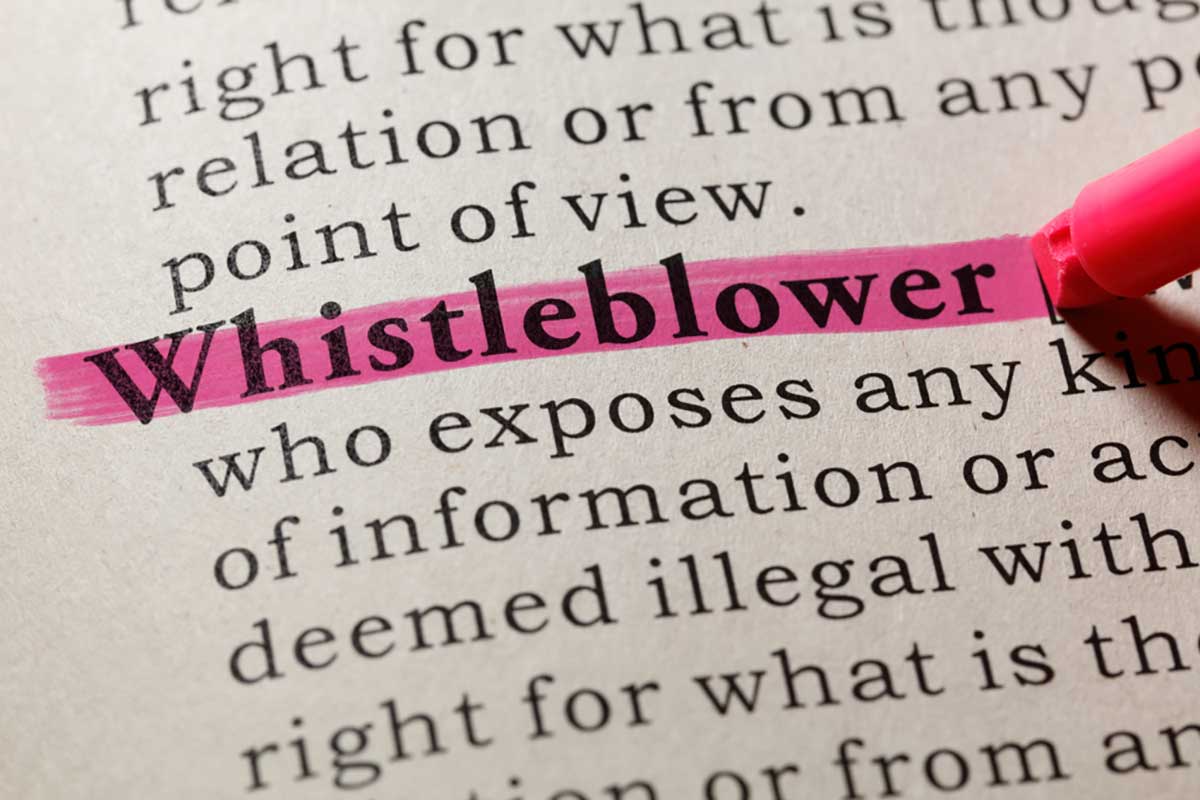Corruption in the workplace affects both the public and private sectors in the European Union. Research shows that 68% of EU citizens believe that there is widespread corruption in their country, with 34% of companies in the EU seeing corruption as a serious problem.
Despite the effectiveness of whistleblowing in stopping or preventing corruption, the Eurobarometer studies show that, of the 6% of European residents who say they have experienced or witnessed corruption, only 15% filed a report. One of the main reasons is that they said they did not know where to report, but 28% said that they felt there was no protection for whistleblowers.
As familiarity with the EU Whistleblowing Directive increases, the latter statistic may change. One of the reasons behind the directive’s development was to change the situation whereby “potential whistleblowers are often discouraged from reporting their concerns or suspicions for fear of retaliation”.
Businesses can play their part in preventing corruption, and this article explores the methods for achieving this goal.
1.The impact of corruption at work
Corruption at work causes a range of different issues. They include:
- Financial penalties for companies that allow corruption and misconduct to occur within their organisation. In France, for example, businesses found to have committed corruption could receive fines of up to €5 million or twice the amount of the proceeds related to the offence.
- Reputational damage for businesses that have been found to have allowed corruption to occur. Clients and suppliers might not trust the organisation and could decline the opportunity to deal with the business.
- Low employee morale and retention. When businesses allow corruption and other wrongdoing to flourish, it can sour the working environment. Coupled with fines levied at the company, this can encourage staff members to seek employment elsewhere.
2. What causes corruption in the workplace?
A culture of corruption can develop within an organisation for a number of reasons. It could be as overt as institutionalised corruption, whereby the wrongdoing is embedded in the company’s processes. But it can also happen where there is a high-pressure environment where staff members have autonomy and sometimes overstep the mark to hit their targets.
Other factors behind corruption in the workplace include a culture that dismisses and punishes whistleblowers as troublemakers rather than tackling complex potential misconduct issues.
Without transparency and accountability being shown to be prized within the company, it is possible that corruption can occur and create problems for the business.
3. How to stop corruption in the workplace
Following you find a step-by-step guide on how to prevent corruption. While we list 5 ways to stop corruption, keep in mind that you might need to adjust it to your company's needs.
3.1 Assess corruption risks
Corruption risks feed into all other aspects of risk management for a business, which is why you should dedicate time to assessing your corruption risk factors. This is how they relate:
| Risk | How corruption risk relates |
| Fiduciary risks | Using funds for purposes other than that for which they are intended |
| Safety risks | Undertaking actions that increase the chances of someone being injured or becoming ill |
| Legal risks | Perpetrators breaking laws as a result of corruption |
| Operational risks | When the results of the corruption prevent the company from reaching its goals |
| Reputational risks | The message sent out by a company that has failed to prevent, or even actively encouraged, corruption |
| Information risks | When people use data in an incorrect manner or withhold the information |
Bearing the above in mind, you should look into the operations of your business and assess where the corruption risks lie. If you deal with procurement, for example, there is a risk of bribery occuring. Favouritism and nepotism are other corruption risks, as are weak customer due diligence procedures and the lack of a robust corruption reporting channel.
3.2 Develop an anti-corruption policy
Once you understand the corruption risks that exist within your organisation, you can create an effective and comprehensive anti-corruption policy.
The nature of corruption is that it often extends beyond the boundaries of the business, so your policy should apply not only to employees but also to management, board members, partner agencies and suppliers.
Within your anti-corruption policy, you should promote a zero-tolerance approach to corruption relating to work. It should cover the areas applicable to your organisation, as discovered in your risk assessment. You can also look to EU law to help align your policies with those of the union. For example, the various iterations of the Anti-Money Laundering Directives.
3.3 Establish whistleblowing procedures
As the EU Whistleblowing Directive states:
“Persons who work for a public or private organisation or are in contact with such an organisation in the context of their work-related activities are often the first to know about threats or harm to the public interest which arise in that context.”
Whether your company is covered by the scope of the directive or not, you need to establish a programme to facilitate easy reporting and investigation of wrongdoing. Providing an online whistleblowing reporting channel, such as IntegrityLog, for your employees helps reporting persons flag misconduct in a confidential manner.
You should then task an unbiased person or department with investigating the claim in a timely manner and reporting back. In addition, your whistleblowing policy should provide sanctions for anyone committing retaliation against a whistleblower to give employees confidence that the company will protect them and that it values their intervention. They can access IntegrityLog remotely and don’t have to use a more conspicuous manner of reporting, allowing them to avoid exposing themselves as the whistleblower to the alleged perpetrators.
3.4 Conduct due diligence on third parties
Corruption is not solely an internal risk for businesses. When your company comes into contact with third-party suppliers or clients, there is a risk that corruption on either side of the relationship could cause problems for your business.
You should conduct due diligence on third parties that you work with to ensure that you have done what you can to reduce the opportunities for corruption to occur. Banks, for example, must put clients through know your customer (KYC) due diligence procedures to attempt to prevent their institutions from being used by money launderers.
Any company developing due diligence procedures can be more confident in the external parties with whom they work and avoid the financial and reputational issues that come with corruption risk.
3.5 Communicate and enforce your policy
When you have created your anti-corruption policy, you need to communicate it effectively to your employees and other stakeholders. This requires training to help bolster the message that there is a zero-tolerance approach, as well as to offer the technical knowledge that will enable employees to put into practice your policies.
To create this culture of compliance, you need to highlight your policy as much as possible. Make the policy accessible on a shared workspace, add links to internal company communications emails and incorporate it into your company town hall meetings.
You should also be seen to enforce the policy and crack down on any corrupt behaviour. Otherwise, people will not take it seriously and will be more inclined to contravene it.
4. Examples of identifying corruption
Companies should be alert to the signs of potential corruption within their organisation. Some examples of corruption include:
| Type of corruption | What it means |
| Questionable invoices | Unprofessional-looking or incomplete invoices, as well as those that don’t correlate with purchase orders, could mean that someone has falsified them and that the money is not going to the intended source. |
| Conflicts of interest |
Where an employee stands to benefit at the expense of the company or one of its clients, this could lead to |
| Incomplete travel expenses | Travel expenses that cannot be linked directly to reasonable costs could be concealed bribery payments or corrupt use of company funds. Overly large expenses could be a red flag that something is wrong. |
| Trading of information | Employees benefiting from sharing confidential information could come as a result of payments being made from third parties or the unlawful distribution of inside information for profit – insider dealing. |
| Collusion | When a party within the organisation makes a secret deal with an internal or external party that benefits them but not necessarily the company or its other employees. |
5. FAQs
5.1 What are some examples of transparency measures in the workplace?
You can instil a culture of transparency in the workplace by requiring open communications, making financial reporting public and giving open access to company data.
5.2 What is the difference between corruption and bribery?
Corruption is any abuse of a person’s position for gain. Bribery is related to the giving or receiving of payment to facilitate an advantage.
5.3 What is the difference between active bribery and passive bribery?
Active bribery is the act of giving the bribe, whereas passive bribery is the receipt of the bribe. It does not matter which party instigated the bribe; these definitions remain the same.
6. Conclusion
Corruption in the workplace is detrimental to an organisation in terms of financial penalties, reputational damage and the effect it can have on staff morale. However, there are steps you can put in place to create a compliance culture and reduce the opportunities for corruption. One of the most effective routes is to establish a robust whistleblowing policy.
As part of that, using IntegrityLog as a reporting channel enables you to fulfil the regulatory requirements relating to GDPR and whistleblowing reports in EU member states. It also helps you keep track of investigations and maintain confidentiality for reporting persons. Request a demo today to find out how it can help you battle corruption.
7. References and Further Reading
Share this post
Article Summary
- 1. The impact of corruption at work
- 2. What causes corruption in the workplace?
- 3. How to stop corruption in the workplace
- 3.1 Assess corruption risks
- 3.2 Develop an anti-corruption policy
- 3.3 Establish whistleblowing procedures
- 3.4 Conduct due diligence on third parties
- 3.5 Communicate and enforce your policy
- 4. Examples of identifying corruption
- 5. FAQs
- 5.1 What are some examples of transparency measures in the workplace?
- 5.2 What is the difference between corruption and bribery?
- 5.3 What is the difference between active bribery and passive bribery?
- 6. Conclusion
- 7. References and further reading





